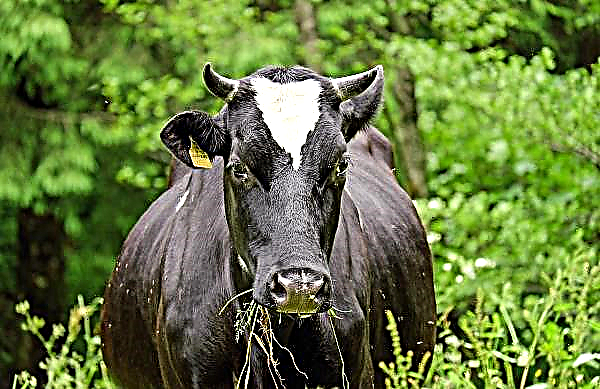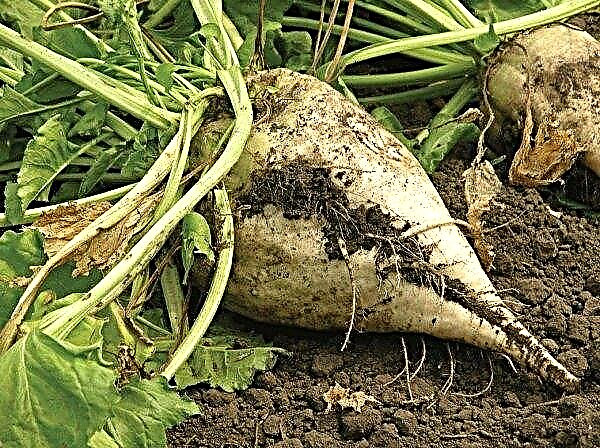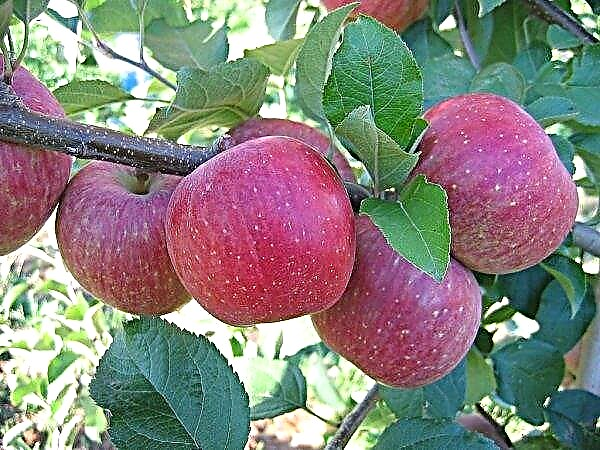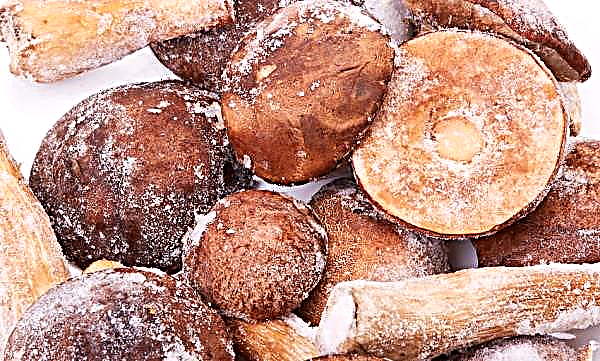Decorating the site with a variety of conifers and shrubs is fashionable and stylish, in addition, it is useful. But, unfortunately, not every evergreen plant is suitable for growing under given conditions, so you need to be serious about choosing a variety. Below we will talk about where and how to plant one of the most decorative varieties of oriental spruce - Aureospicat, so that it can show its beauty to the maximum extent.
Botanical Description
Aureospicata is a representative of the eastern species of spruce, brought to Russia and other countries formed on the territory of the former USSR from Poland. The decorative variety was bred in 1890 by German breeders on the basis of a nursery located in Karlsruhe, Baden-Württemberg (according to another version, the nursery was in Hamburg, and the event happened 17 years earlier), but still continues to be almost the most popular conifer among those used in landscape design.
 The crown shape of Aureospicata is characteristic of all fir trees - wide below and gradually tapering upward. At the same time, the length of the skeletal branches, including inside the same tier, is not the same, and therefore the overall silhouette of the tree, while maintaining a cone-shaped direction, looks asymmetrical and somewhat loose.
The crown shape of Aureospicata is characteristic of all fir trees - wide below and gradually tapering upward. At the same time, the length of the skeletal branches, including inside the same tier, is not the same, and therefore the overall silhouette of the tree, while maintaining a cone-shaped direction, looks asymmetrical and somewhat loose.
An adult tree can reach 15–25 m in height and have a crown diameter of up to 6–8 m at the base, although they often speak of a height of 10–12 m and a width of 4–5 m. Moreover, since the variety is characterized as slow-growing, usually Aureospicata has even more compact dimensions.
So, the height of a ten-year-old spruce averages 2.3–3 m with a crown diameter of not more than 1.5 m, and even by the 30th year of life, with good care, a tree gains only 70–80% of its natural size.
Characteristics of Aureospicate spruce:
| Side shoots | In the lower part of the trunk they are directed from top to bottom, as you approach the apex, the angle of growth becomes more acute. Well branched. Young shoots begin to appear quite late (in comparison with other species of spruce) - only by the beginning of summer. |
| Bark | At a young age, smooth, cracking as the tree grows older. The color is light brown. |
| Needles | Short, no longer than 1 cm, shiny, stiff and dense. The ends are pointed, the color of the young shoots is golden yellow, then it becomes light green and, finally, dark green. |
| Flowers | Heterosexual. Men's are oval, red and small in size. Female ones are larger (up to 2.5 cm), in color there is a pronounced purple hue. Flowering period is May. |
| Fruit | They are similar in shape to a cylinder with a length of 5–8 cm and a diameter of 2–3 cm. The color at the beginning of ripening is red-violet, then begins to turn light brown. The bumps look decorative. |
Origin of name
The name of the considered variety of spruce is compound and comes from the combination of two Latin words - “aureo”, which means “golden”, and “spicata”, that is, “spikelets”. Usually, this phrase is translated into Russian as “golden tips”.
Looking at the spectacular yellow color of the young growth characteristic of this spruce (as well as the thuja mentioned above), the origin of the name of the variety leaves no doubt.Important! Eastern spruce Aureospekat should not be confused with the popular variety of western thuja, which has the same species name. In order not to be mistaken, when buying a seedling it is better to focus on the full name of the tree: in the first case it is Picea orientalis Aureospicata, in the second - Thuja occidentalis Aureospicata.

Landing
Theoretically, Aureospicato can be grown from a seed or root a green or lignified cuttings, but it is better to use a ready-made seedling grown in a specialized nursery for planting. The optimal age of planting material is 2–4 years (trees that have reached 10 years old cannot be transplanted to a new place, therefore they cannot be used as seedlings).
Did you know? In 1993, the Royal Horticultural Society of Great Britain awarded Aureospicat firs the highest annual award, the Award of Garden Merit (AGM).
Experts recommend buying spruce in a container so that its root system is closed by an earthen lump. In this case, planting is carried out by transshipment, and the plant tolerates stress much more easily. In addition, such seedlings can be planted even in summer, while the traditional time for planting is early spring or late autumn.

It is important to choose the right place for the Christmas tree. Aureospicate can grow on various types of soil (although a fertile light mixture with an acidic or slightly acidic reaction, for example, sandstone, is preferred), but it does not tolerate swamping. Therefore, it is preferable to plant a tree on a hill or in a place where groundwater does not lie too close to the surface of the earth.
Important! When planting tall trees, which include the Aureospicata, you should always consider the minimum permissible distance between the "neighbors". So that the crown of the spruce can develop, the distance between it and other plantings should not be less than 3 m.
In addition, before laying the soil mixture in the pit, it is necessary to pour a layer of crushed stone, broken brick or gravel, reliable to ensure good drainage - at least 15 cm. Subject to this rule, the depth of the landing pit should be at least 70 cm. The approximate diameter is 50 cm, although in general, you should focus on the volume of the earthen container in which the seedling is sold, and increase this size by about half.
Spruce, like other coniferous plants, does not tolerate heavy and dense soil, so the substrate for planting a seedling should be lightened with sand and peat. In addition, to provide the tree with food in the first years of life, the soil should be fed with organic matter and mineral fertilizers.
As an optimal option, a ready-made substrate for conifers is suitable for this purpose, but you can prepare the nutrient mixture yourself by mixing the following components:
- fertile soil (leaf or sod soil) - 4 parts;
- vermicompost - 1 part;
- peat - 1 part;
- sand - 1 part;
- complex mineral fertilizer, for example, Nitroammofoska - 100–150 g per one plant.

When closing the pit, you should ensure that the seedling is in a strictly vertical position, and its root neck is neither deepened nor raised above ground level (the latter condition is critically important for the spruce to take root).
Immediately after planting, the soil around the tree must be carefully tampered to prevent the void from being preserved, and then it is plentifully watered with slightly heated water, in which it is previously recommended to dilute the root crop and growth stimulant (preparations such as Kornevin, Epin at the rate of 10 g per bucket of water ) When moisture is completely absorbed into the soil, the area of the trunk circle is mulched with sawdust, pine bark or coniferous substrate.

This will protect the soil from drying out, block the development of weeds, and also create a favorable environment for rapid root growth by introducing the fungi contained in such material into the soil, which in nature create strong biological bonds with conifers, nourishing and protecting each other (the so-called "Mycorrhiza").
Did you know? The age of the oldest spruce in the world is, according to scientists, about 4000 years. This "venerable" tree grows in the Iranian province of Fars, near the administrative center of Abad.
Growing conditions
Aureospicata - unpretentious tree. But in order for it to quickly take root and preserve the inherent decorativeness of the variety, it is necessary for him to initially create the most favorable conditions.

The basic requirements are:
| Lighting | Better reinforced. Penumbra is permissible, but undesirable. At the same time, at a young age, the seedling should be protected from direct and too bright sunlight. |
| Wind protection | Required |
| Watering and humidification | All spruce trees are characterized by low drought tolerance, in extreme heat they begin to wither and lose their attractiveness. Therefore, it is important for the tree to ensure regular hydration, and this applies not only to watering, but also sprinkling (spraying). |
| Soil care | Mulching. If this technique is not used, after each watering or rain, the soil needs to be loosened, preventing it from being knocked into a heavy and dense lump, and weeds must be constantly weeded. |
| Frost resistance | High. In different sources, the tree belongs to the 5th or 6th zones of frost resistance. |
| Air pollution resistant | Above the average. This quality of the Aureospicate compares favorably with many decorative conifers, due to which it can be planted even in those areas that are in relative proximity to the city, busy highway or other sources of gas contamination, smoke and dust. |

Spruce care
If during landing all the necessary conditions are taken into account, and the process itself was carried out in compliance with the recommended technology, subsequent care
The aureospatic does not present any special difficulties and is reduced to the following standard procedures:
- Watering. The frequency depends on weather conditions, however, if the summer was dry, moistening is carried out 1-2 times a week, this is especially important for young seedlings. The minimum water consumption per tree is at least 10 liters.

- Loosening. From time to time it is useful to loosen the soil around the tree with a hand cultivator to a depth of 5-6 cm, mixing it with a compacted layer of mulch, which in this case very quickly turns into organic fertilizer. After loosening, the mulch layer should be renewed. The number of such procedures per season can be brought up to 4–5 pieces.
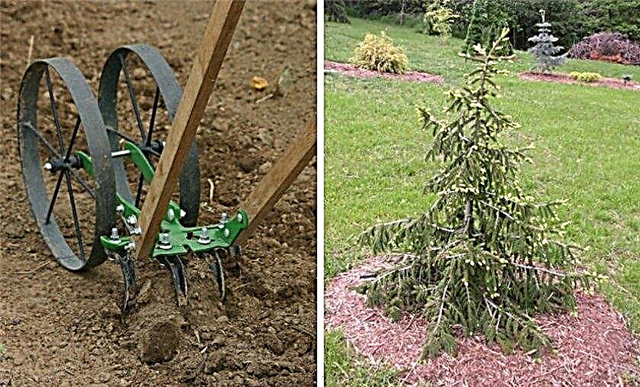
- Top dressing. Fertilizing does not need to be carried out too often, it is enough to do this twice during the season. It is better to use special mixtures for conifers for this purpose, and add “Chelatin” to the water during spraying - thanks to this preparation, which compensates for the lack of iron in the needles, the spruce will always maintain a bright and beautiful color.

- Pruning. Forming a crown of spruce is not necessary. At the same time, young Aureospicata seedlings tolerate a haircut well and, unlike adult trees, quickly recover after such a procedure. Mandatory is the removal of damaged, dried and improperly growing (disturbing neighbors) branches. The best time for this is the beginning of summer.
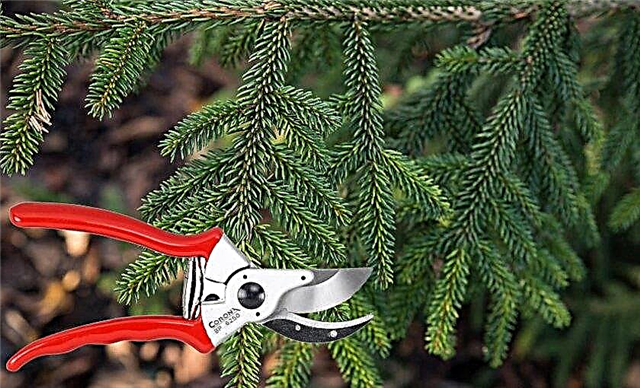
- Preparing for the winter. In areas where climatic conditions are close to the threshold indicators of winter hardiness, young trees need to be carefully covered with coniferous paws before the start of winter, not forgetting to carry out abundant winter watering first.

In particular, spruce is occasionally affected by pests and diseases:
| Pests | Disease |
|
|

The methods of struggle depend on the specific problem, but the first place is always the determination of the cause of the disease and its elimination (adjustment of care). If the tree could not be cured in this way, more radical measures are used - insecticides (drugs against insect pests), fungicides (antifungal agents) or aucaricides (protection against ticks).
The use of wood in landscape design
Due to its low growth rate and compact crown shape, spruce eastern Aureospicata is suitable for decorating small areas, although such a tree can always find a worthy place in the vast territory.
Spruce can be used in a single landing or in a group, including for the decoration of hedges. In the latter case, depending on the size of the plot, either a row of fir trees of the same variety planted maximally (up to 2 m) close to each other is formed, or the so-called “classic mixborder” is a combination of several coniferous (sometimes mixed with deciduous) plants arranged in the form single line. Eastern spruce Aureospicata deservedly received the characteristic of unpretentious, resistant to changing climatic conditions and at the same time very beautiful coniferous tree. Designers recommend combining Aureospicata with flowers, trees or shrubs whose leaves have dark shades. In such groups, the golden needles of young spruce spruce usually look especially advantageous. In addition, tall conifers are often planted on the border of the site or sekitei (Japanese rock garden). And if you choose the central part of the yard for a tree, it will make an excellent New Year tree, around which you can drive funny round dances with the whole family.
Eastern spruce Aureospicata deservedly received the characteristic of unpretentious, resistant to changing climatic conditions and at the same time very beautiful coniferous tree. Designers recommend combining Aureospicata with flowers, trees or shrubs whose leaves have dark shades. In such groups, the golden needles of young spruce spruce usually look especially advantageous. In addition, tall conifers are often planted on the border of the site or sekitei (Japanese rock garden). And if you choose the central part of the yard for a tree, it will make an excellent New Year tree, around which you can drive funny round dances with the whole family.
The variety looks incredibly bright in early summer, when an elegant and slender plant is covered with young shoots, densely covered with golden yellow needles, but it is no less attractive also in September and October, when large purple cones ripen. However, the spruce is good because it does not lose its decorative effect throughout the year, even when the entire site looks bare and dull.







